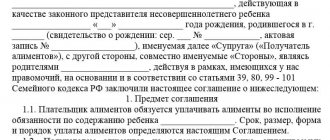The presence of legal ties identical in content to the relationship between parent and child is certified by an official document: an adoption certificate. Adoption itself is a legal action aimed at protecting the interests of a minor child who, for various reasons, was left without the care of his father and (or) mother. This procedure has its own characteristics and difficulties, which is reflected in the Family Code of the Russian Federation. And adoptive parents, like parents, must ensure his normal upbringing, development and training. And after adoption, the natural parents of the child lose all rights in relation to their child.
Adoption Certificate
An adoption certificate or adoption certificate (which is essentially the same thing) is the main document confirming that a child is recognized as a member of a particular family and has material and non-material rights.
Certificate of adoption
The document also defines the rights of new parents. To obtain a certificate, you must contact certain authorities. The process itself is not very fast and takes some time. After submitting a set of necessary papers to the Civil Registry Office, the adoptive parent is registered as a parent.
The certificate contains the child’s details and the name of the city in which he was born. It is worth noting that parents who adopt a child have every right to change the data. If the child is over ten years old, the data can be changed only with his consent.
The child's date of birth is also indicated on the certificate. Again, it can be changed up to a year.
The range of changes should not be more than three months. If the child has exceeded the age of one, then adjusting the date of his birth is impossible.
As in a regular birth certificate, the document contains the details of the adoptive parents, their last names, first names and patronymics, and information about their citizenship. In addition, the certificate contains the date of registration of the adoption, the number of the entry in the registration book in the registry office, information about the registry office itself and the date when the document was received in hand.
Do last names, first names and patronymics change upon adoption?
If a child is born to his mother and father, the parents give him a surname, which they themselves bear, and also choose a name. The personal data of the son or daughter is entered into the documents (deed record and birth certificate) and is preserved for life.
Even after the death or deprivation of parental rights of the mother and father, the son or daughter retains the same personal data.
When entering a new family, an adopted child also retains personal data - first name, last name and patronymic (Clause 1 of Article 134 of the RF IC). But if the adoptive parents wish, for the sake of maintaining the secrecy of adoption, these personal data can be changed.
The rules and procedure for changing each element of personal data - last name, first name, patronymic - are provided...
- Art. RF IC (the right to change the name, surname, patronymic of an adopted child);
- Art. Federal Law of the Russian Federation “On acts of civil status” (contents of the registration record of adoption);
- Chapter VII of the Federal Law of the Russian Federation “On acts of civil status” (procedure for changing a name).
Surname
The rules for changing a surname after adoption are specified in Art. RF IC:
- if the adoptive parents did not ask the court to change the child’s surname, the previous surname remains after adoption;
- if the adoptive parents have different surnames, they have the right to decide for themselves whose surname will be assigned to the adopted child;
- if there is an intra-family adoption (by a stepfather or stepmother of a stepson or stepdaughter), with the permission of the blood parent, the son or daughter may be given the surname of the adoptive parent.
Example
When getting married, the woman kept her maiden name. When the couple decided to adopt a girl, a dispute arose between them: whose surname to give to their daughter. They decided to submit the controversial issue to the discretion of the court. But since the application submitted to the court did not contain a request to change her last name, the court by default left the girl with her previous personal information.
If the issue of changing a surname concerns a child who is already 10 years old, the court must ask his permission. The only exception is when the court does not involve the child in the trial and does not ask his permission: he has been living in the adoptive family for a long time, and considers them his natural parents (RF IC).
Surname
The rules for changing patronymics after adoption are also specified in Art. 134 RF IC:
- if the adoptive parents are a married couple, the child may be assigned a new patronymic, formed on behalf of the adoptive parent;
- if the adoptive parent is a single woman, she can keep her previous middle name or choose a new one at her own discretion;
- if the adoptive parent is a single man, the child may be given a new patronymic, formed in his name.
- If an intra-family adoption occurs (by a stepfather - a stepson or stepdaughter), the patronymic, formed on behalf of the adoptive parent, can be assigned with the permission of the natural mother.
You must directly ask the court to change the child’s middle name.
If the application submitted to the court does not contain a request to change the patronymic, after adoption, by default the previous patronymic will be retained - formed on behalf of the natural father or other male name indicated by the single blood mother during registration.
Example
A man filed a lawsuit to adopt his 5-year-old stepson, his wife’s own son. The mother agreed to give her son a patronymic, formed on behalf of his stepfather, instead of the patronymic that she indicated when registering the birth.
Name
Changing a child's name is possible by a court decision during adoption (Article 134 of the RF IC) at the age of….
- up to 10 years - at the request of the adoptive parents;
- from 10 to 18 years old - at the request of the adoptive parents and with the consent of the child himself.
Who issues?
After the trial, a copy of the positive decision is transferred to the registry office, where the adoption procedure is officially registered. After this, adoptive parents can collect a set of documents to obtain an adoption certificate. It is drawn up and issued by an employee of the civil registry office.
The set of required documents should include:
- application from adoptive parents;
- a copy of the procedural document;
- documents of both parents;
- child's birth certificate.
Adoptive parents can receive the document at any time. The civil registry office has no right to refuse them!02
Statement
The petition, which is submitted to the registry office, is written by parents by hand in the prescribed form.
In the upper left corner you must write the number and date of recording the adoption act. In the right corner you must write to which body of the registry office the petition is being submitted and from whom.
After this, you need to write “application for adoption” in the middle and state your request in any form. At the end of the application, information about the adoptive parents is indicated and signatures are placed. If the family is complete, then signatures are required from both the adoptive mother and the adoptive father.
Registration of adoption will take place on the day the application is submitted. After which the civil registry office employee is given two weeks to issue the adoption certificate, and the finished document is handed over to the adoptive parents.
Fill out the application carefully using blue or black ink!
Required items
As mentioned above, the application for adoption is submitted in free form. However, there are a number of necessary points that should be taken into account when writing.
The application must describe in detail your relationship with the adopted child.
It must be emphasized that adoption occurs at the free will of the adoptive parents. They must briefly outline the family’s living conditions and a brief plan for raising the child.
If the child is over 10 years old, adoption can occur with his consent. If this is hidden by the adoptive parents, then they must disclose this in their application. Among other things, the adoptive parents and the child must undergo a medical examination, the results of which are also reported in the application.
The results of the medical commission are valid for three months. Don’t delay contacting the registry office!
Who issues the certificate
As mentioned earlier, here we are talking about an official state form, which gives certain rights and obligations not only to the adoptive parents, but also to the adopted orphan. The official form must be completed as soon as possible immediately after the court has made a positive decision on the adoption request, and the guardianship authorities and the child himself have agreed to the adoption. Next, in order to formalize the current one, an appeal is made to the competent authority, where the executed document is presented. Let's take a closer look at where trustees can go to receive paperwork:
- is authorized to issue this document to the civil registry office, which is present at the place of permanent registration of the trustee;
- In addition, you can obtain this state form at the place of temporary registration of the adoptive parents of a minor child;
- separately, such paper can be provided in the area where the child is registered at the orphanage address.
In any case, only the Civil Registry Office is authorized to issue such a certificate. At the same time, the execution of the document cannot be refused, since in order to obtain it, the foster trustees have in hand a court order that has already entered into legal force. This official document is provided in writing, but there is a fact that information from the certificate is also disclosed orally to the trustees.
Required documents
In order to obtain a certificate of adoption of a child, in addition to the application, adoptive parents must submit the following documents to the registry office:
- a copy of the procedural decision;
- passports;
- child's birth certificate;
- conclusion on the passed medical examination.
A personal identification document can be not only a civil passport of the Russian Federation, but also, in its absence, a foreign or service passport received in Russia, as well as a sailor’s passport. Based on this, the final registration of adoption takes place.
State registration of adoption
The basis for state registration of adoption (hereinafter referred to as adoption) is a court decision establishing the adoption of a child that has entered into legal force.
According to Russian law, adoption is allowed only for minor children. Adoption is carried out by the court upon the application of persons wishing to adopt a child, in a special proceeding according to the rules of civil procedural legislation.
State registration of the adoption of a child is carried out by the civil registry office at the place where the court decision was made to establish the adoption of the child or at the place of residence of the adoptive parents (adoptive parent).
The law limits the adoption of children - citizens of the Russian Federation - by foreign citizens to certain conditions.
Validity
Before the court hearing, adoptive parents must collect and submit for consideration a whole set of documents:
- certificate from the epidemiological station;
- certificate of no criminal record;
- form No. 9 from the Housing Office;
- bank account statement;
- conclusion on the medical examination passed;
- characteristics and certificate from the place of work.
Each of these documents has its own expiration date. This must be taken into account. After the court hearing, the decision on adoption is transferred to the registry office, where it is officially documented that the child now has a new family. The decision is valid for 2 years. A certificate from the SES and a certificate confirming that the adoptive parents have no criminal record are valid for exactly one year. Form T-9 and bank account statement are valid for no more than a month.
The employment certificate and reference will be considered valid until the end of the calendar year. Also, before contacting the registry office, parents and the child must undergo a medical examination. Its results will be valid for 3 months. After this period, if the certificate is not received, the commission will have to be repeated.
It’s better to do everything on time than to go through all the authorities again and waste precious time!
Types of income in 2020
As noted earlier, mothers of many children who have had a fourth birth or who have adopted a similar minor can count on significant payments from the state (municipality).
Important! Some subsidies are provided at one time. Such preferences are transferred immediately after the baby is born.
Regular receipts, in turn, are assigned and transferred for specific periods (quarterly, monthly, annually). Most often, subsidies are monthly.
Since February of this year, the one-time amount provided for the birth of a child is 17,479.73 rubles. Before this time, it was 16,759.09 rubles. Thus, there was an increase in the size of the preference
It is important to remember the timeliness of the mother’s actions. So, if she cares about her health and the well-being of her offspring, then she will register with a medical institution in the early stages of pregnancy (the first 12 weeks)
In this case, the family budget will be replenished by 655.49 rubles.
To apply for a one-time support measure, parents need to prepare documentation and submit it to the employer or the social security authority until the minor turns six months old. The amount of financial assistance is constantly indexed by decision of the Government of the Russian Federation by the appropriate coefficient. Thanks to this, the income of young parents is constantly increasing.
If a child is born to military parents, the benefit amount is paid in the amount of the citizen’s allowance. The amount may also vary depending on the area of residence of the family and living conditions in the area.
If a citizen has decided to adopt several children who are brothers (sisters), then she is entitled to a subsidy in the amount of 133.6 thousand rubles.
At the birth of a baby and his official registration, carried out in accordance with the requirements of current legislation, 3277.45 rubles are credited to the parent’s account. However, the indicated size is determined for the firstborn. For subsequent children, the state provides 6554.89 rubles/month. Children of military personnel are entitled to a preference in the amount of 11.9 thousand rubles.
Important! Regional (local) measures to support families with many children are established by acts corresponding to the level. Their value directly depends on the budgetary capabilities of local authorities
Currently, residents of 69 constituent entities of the Russian Federation can apply for financial assistance from local authorities. However, in some regions such privileges were excluded, since budgetary opportunities did not allow generous sums to be provided to mothers and fathers with 4 or more children. Preferences increased by one and a half to two times are given to parents living in the Far East and in the KS (equivalent territories). This rule applies to all benefits (one-time, monthly, etc.).
Regional preferences are usually provided for third and subsequent children. At the same time, the average per capita family income should not exceed the subsistence level established in the subject. One-time support is provided on an application basis. The list of benefits and compensation includes the following types of assistance:
- discount on utility bills (about 30%);
- free medication provision for minors;
- free travel on intracity transport (without limiting the age of the child);
- extraordinary admission to kindergarten;
- obtaining land ownership free of charge. The criterion for selecting beneficiaries is their need for housing or improvement of existing housing conditions;
- monthly reimbursement of expenses for using a landline telephone;
- annual compensation for the purchase of a set of clothes for a schoolchild;
- provision of free linen for newborns;
- exemption from fees for solid waste removal for minors. In this case, family members can qualify for a fifty percent discount;
- free meals in school canteens;
- free textbooks;
- 100% discount for keeping your child in kindergarten;
- free visits to museums;
- rest in a sanatorium or summer camp.
Question:
What can a mother expect when giving birth to several children at the same time?
Answer:
Current legislation provides for preference in connection with the simultaneous birth of several offspring. If a young mother gave birth to twins, triplets, etc., then depending on her place of residence, the woman will receive from 30 to 50 thousand rubles. This amount is a significant addition to the family budget of a couple in need of money. Help helps reduce the financial burden on the mother and father of the children, who will be able to meet the basic needs of the child.
Replacement if a document is lost
It happens that the adoption certificate may be lost.
In such cases, do not worry - the certificate can be restored. To restore the application, adoptive parents need to go to the civil registry office where the previous certificate was received and write a request for the issuance of a repeat document or duplicate.
The application must be accompanied by identification documents of the adoptive parents; receipt for payment of state tax; a document with which you can confirm your right to receive this certificate.
If, at the request of the parents, another person applies to the registry office, then they will be required to draw up a power of attorney for him. If parents have certain benefits, then they can attach a supporting document to the general set of papers.
Civil registry office employees may well refuse to issue a duplicate adoption certificate to persons who are not the official adoptive parents of the child. For making the secret of adoption public, they will be punished according to the law.
How to adopt a child
Only adults of different sexes who are in an officially registered marriage have the right to be adoptive parents upon presentation of a marriage certificate. The certificate can be obtained by:
- persons with citizenship of the Russian Federation who permanently reside both on the territory of Russia and abroad;
- persons who have citizenship of another state;
- persons who have no citizenship at all.
State registration of the fact of adoption is within the competence of the civil registry office, which is authorized to issue the appropriate certificate.
The main document initiating this procedure is a court decision on an adoption application that has entered into legal force. It is submitted by persons wishing to adopt to the court at the child’s place of residence, attaching to it (in two copies) the following mandatory documents:
- copies of identification documents of potential adoptive parents;
- copies of birth certificates of adoptive parents;
- a copy of a document confirming the fact of registration of marriage between potential adoptive parents;
- written consent of the second spouse or other document indicating the termination of family relationships between the spouses, subject to the adoption of a child by one of them;
- a medical certificate containing reliable information about the health status of each of the adoptive parents;
- documents containing information about the actual level of income of the adoptive parents and their place of work;
- a document containing information on providing foster parents with normal living conditions;
- a document certifying the registration of persons with the appropriate registration of applicants for adoptive parents;
- conclusion of the guardianship and trusteeship authority on the advisability of adoption, based on the interests of the child;
- a document certifying that potential adoptive parents have undergone special psychological and legal training for the adoption of a minor child into the family.











